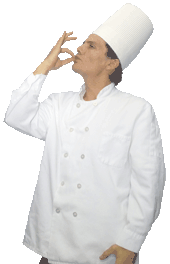A bulb baster is a kitchen tool which is designed to make basting things like roasts much easier. The classic design is often closely associated in the mind of consumers with turkey, and it is sometimes more commonly known as a turkey baster. There are numerous uses for a bulb baster around the kitchen, and most are relatively inexpensive, making them a handy investment.
The basic design of a bulb baster includes two parts. The first is a long metal, glass, or plastic cylinder which can hold basting liquids. The cylinder also distances the hand of the chef from potentially hot pans and foods, reducing the risk of burns. The second part is the bulb, made from plastic, silicone, or rubber. The bulb is squeezed to draw liquid up into the cylinder, then gently squeezed to release them. A high quality baster can create quite a vacuum, sucking up a large amount of liquid for basting or removal from a pan.

Basting foods as they cook ensures that they stay moist, flavorful, and evenly browned. Typically, basting is done with drippings from the pan, efficiently recycling them and preventing the bottom of the roast from getting soggy. A bulb baster may also be used to apply a marinade. The tool is also useful for removing excessive liquid from a pan. Warming the baster before use tends to make it more effective, and can be accomplished by running the baster under warm water.
While the basic design of a bulb baster is simple, there are a number of optional tips which may be included. In some cases, the baster is paired with a basting brush, which attaches to the end of the tube. An injection needle can also be used to penetrate the roast with the basting liquid. Some companies also design dripless tips, which help the bulb baster retain the fluids until they are needed.
The quality of bulb basters varies widely. Many companies make the tools out of less than ideal materials, meaning that they can fail, sometimes at very inconvenient moments. As a general rule, you want to find a baster which can be easily cleaned, often by removing the bulb. Silicone is a great material for bulb basters, since it is heat resistant. Try to avoid thin plastics, as they may crack or melt.
